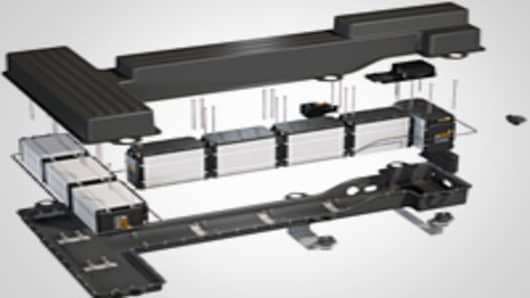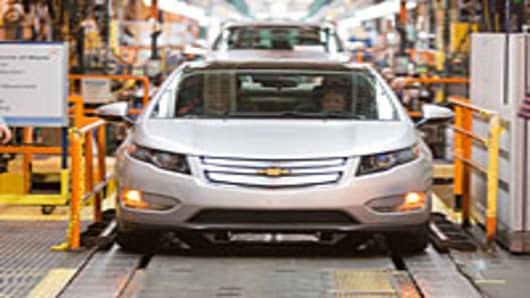While the recent torrent of new hybrid auto models may be slowing, hybrid technology, especially in fossil-fuelled cars, is just picking up speed.
"I see the market moving quickly to 'microhybridization'" says David Vieau, CEO of battery makerA123 Systems, referring to the implementation of fuel-stretching hybrid components across all new vehicles, including gas-guzzling light trucks and SUVs.
The main component of this microhybridization is the "start-stop" system, which shuts off an idling gas-powered engine when the vehicles comes to a stop, and then uses stored electricity rather than gasoline to get it moving again.
"That first burst of the gas combustion engine is very inefficient," says Vieau, pointing out that an electric start is quieter and more fuel efficient.
Various industry studies have shown that vehicles that operate most often on congested city streets could see a 5-10 percent increase in fuel efficiency just with start-stop technology.
John Gartner, transportation analyst at clean tech research firm Pike Research, thinks it could be up to 15 percent in savings — from a technology that he says could add as little as 10 percent of the hybrid premium onto the sticker price.
With "full" hybrids like Volkswagen's new 2013 Jetta — to be unveiled at this year's North American International Auto Show in Detroit — commanding an average of $5,000 over the cost of a gas-powered comparable vehicles, these "micro hybrids" or "start-stop vehicles", SSVs, that could add as little as $500 onto the price of a car.
Compare that to electric-only vehicles like the Nissan Leaf, which can costs up to $10,000 more than a comparable gas-powered vehicle, and requires another $1,000 for the charging technology at home or work.
A typical commuter would see a payback in gas savings within two years, according to U.S. Department of Energy gas pricing and consumption data.Consumers now have dozens of hybrid vehicle options from which to choose, with almost every carmaker, from luxury marquees Porsche andto mass market makers Ford Motor and Honda , making at least one "full" hybrid.
These new models include plug-in electric vehicles with gas engines to extend their range, like GM's Chevy Volt, or non-plug-in versions that have both electric and gas-powered motors, like the ToyotaPrius.
But analysts say the real market penetration for hybrid technology will be in vehicles whose owners may think they're buying a fossil fuel-powered engine.
Pike's Gartner says SSVs are unlikely to cannibalize the existing hybrid market, but he adds that these micro-hybrids will instead do battle with smaller, more fuel-efficient gas-powered vehicles.
"They'll most directly face competition from smaller compact vehicles that can offer similar fuel efficiency by reductions in weight and in other technologies" like fuel injection and aerodynamic improvements, he says.
Driven by a need for fuel efficiency in expensive gasoline markets, European and Japanese fleets have used this technology for a number of years, but it's just coming to North America now.
Over 20 SSV models were available in Europe in the 2011 model year, but only three were in North America.
In 2011, about seven SSVs were sold for every two hybrids in 2011, but Gartner sees that growing to 16-to-1 by 2017, due to lower cost of adoption.
He adds SSVs would typically be sold under an "eco" or "blue" label, and come standard on some newer vehicles or as an option on others.
A123's Vieau says that once the battery pack is installed for stop-and-start, other energy recovery technologies become more inexpensive since the storage issue is solved.
Other "hybridization" technologies use years-old concepts like regenerative braking systems, which grab the otherwise-lost energy from braking a car, to embedded solar panels designed to replenish batteries while driving.
For firms like Vieau's, wider application of battery technology is good news, since the pure electric vehicle, EV, market is still small.
"The largest [green vehicle] population will be microhybrid, and the smallest will still be EVs" by 2015, he predicts.
He says EVs are still expected to be a small overall player for the next 10 years, but "from a communications standpoint, all of the focus is on EVs."
He adds his firm is still bullish on EVs — especially since EVs need 10 times the battery capacity of hybrids, meaning more potential sales for his firm — but he expects more focus on battery technologies across all vehicle platforms, including SSVs.
Hybrids have become so ubiquitous it's easy to forget the first Toyota Prius rolled off a car lot in the U.S. in 1999. The Japanese automaker will debut the redesigned version of its flagship hybrid, the Prius v, for the 2012 model year.
But with gas prices still high since that first U.S. Prius was sold, it's the economic motive that has pushed hybrid technology into the mass market.
Squeezing more miles out of a tank of gas has become critical, says Pike's Gartner, when 95 percent of world's vehicle fleet still uses fossil fuels.
"You're taking the best feature of hybrids and scaling it down," he says, all at a reasonable cost. "That's something that will blow past (full) hybrids in implementation."



